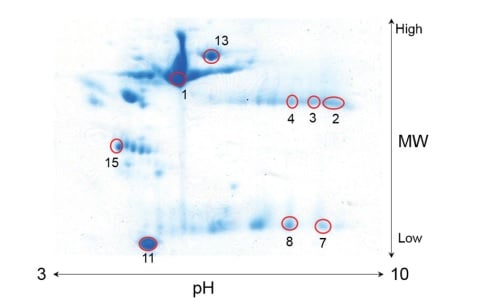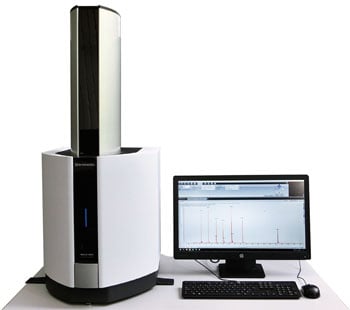Protein Identification from Two-dimensional Gel Electrophoresis Based on Peptide Mass Fingerprinting (PMF) Using a Benchtop MALDI-TOF Mass Spectrometer
At present, shotgun proteomics techniques using liquid chromatography mass spectrometry are utilized mainly as high-throughput methods for identifying many different proteins in cellular cytoplasm. However, these techniques are not necessarily effective for identifying all proteins. In particular, when handling proteins separated by means of two-dimensional electrophoresis etc., the protein spots detected on the electrophoresis gel must be linked to the results of protein identification. For such analyses, there may be many cases where using MALDI- TOF mass spectrometry is more efficient than using liquid chromatography mass spectrometry after enzyme- treating the protein spots separated from the gel. This article introduces an example of protein identification using two-dimensional electrophoresis and a benchtop MALDI-TOF mass spectrometer.
Two-dimensional Electrophoresis of Serum Protein
0.5 μL of human serum was diluted in 100 μL of water. After adding methanol/chloroform/water (3:1:4) solution, the total solution was centrifuged to extract proteins. Then, the extracted proteins were cleaned with methanol and left to dry. A buffer solution for two-dimensional electrophoresis (Swelling Buffer, SHARP) was mixed with reducing agents and ampholytes, and added to the proteins to perform two-dimensional electrophoresis using Auto2D (SHARP). The electrophoresis for the first and second dimensions was performed for a little less than two hours. The gel resulting from electrophoresis was stained with CBB (InstantBlue, Expedeon Ltd.) to detect protein spots (Fig. 1).

Fig.1 Two-dimensional Electrophoresis Gel Image of Human Serum Protein Red Circles: Separated Spots
Benchtop MALDI-TOF MS "MALDI-8020"

Key features:
- Linear mode (positive ion) MALDI-TOF
- 200 Hz solid-state laser, 355 nm
- Load-lock chamber for fast sample introduction
- UV laser-based source cleaning (patented)
- Small footprint/benchtop design
- Quiet operation (<55 dB)


